What Businesses Need Foam Fire Suppression Systems?
If your company handles or processes flammable liquids such as oils and gasoline on a regular basis, a traditional water-based fire sprinkler system won’t provide the protection you require. Industries that handle flammable liquids are often quite large, making them more difficult to protect from fires, and the flammable liquids don’t extinguish when doused with water. In fact, attempting to put out a flammable liquid fire could actually help the flames grow.
That’s why foam fire systems are so important. Examples of industries that should install a foam fire system in their building or property include:
- Flammable liquid storage facilities
- Loading racks
- Processing areas
- Refineries
- Dike areas
- Municipal fire departments
- Aircraft hangars, airports and heliports
- Jet engine test facilities
- LNG storage/manufacturing facilities
- Marine applications
- Warehouses
About Foam Fire Suppression Systems
Fires need three things to burn: oxygen, fuel, and an ignition source. Once ignited, the fire continues to burn as long as there is oxygen and fuel. In an environment that can’t use traditional water-based fire extinguishing systems, a foam fire system separates the fuel from the air, which extinguishes the blaze.
Foam fire suppression comes in a variety of systems. One example is the ANSUL foam fire suppression system. The main fire-fighting agents in foam systems are known as Aqueous Film-Forming Foams (AFFF), and if you choose the ANSUL system, you have a variety of other foam agents to choose from. These are comprised of a combination of hydrocarbon surfactants, fluoro-chemical surfactants and solvents, which require very little energy to produce high-quality firefighting foam.
Choosing the Type of Foam
The type of foam you choose depends on your industry and the kinds of flammable liquids you deal with. For instance:
- Class B Hydrocarbons (AFFF) are ideal for airports, manufacturing plants, and fire departments.
- Class B Polar Solvents (AR-AFFF) are most effective on hydrocarbon fuels, methanol, ethanol, and acetone.
- Class A Foam Agents make water more effective at controlling combustible materials such as wood, paper, coal, rubber, and plastics.
- Class A, B & LNG Fires High-Expansion Foam is the agent of choice for aircraft hangers, flammable liquid storage, and LNG facilities.
- Fluoroprotein Foam is mostly used in refineries and petrochemical facilities.
- Protein Foam is another fire suppressant of choice for refineries and petrochemical facilities.
- TARGET-7 Vapor Suppression is a neutralizing agent that lessens dangerous vapors released from a spill.
If you require foam fire suppression system installation, inspection, testing, repair or replacement, please contact Kauffman Co. today for an estimate!















